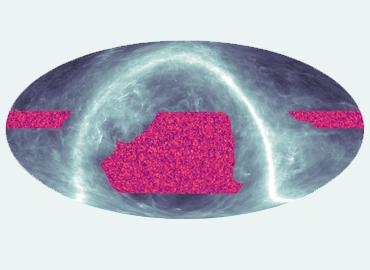Astronomers release the most detailed map of matter in the cosmos
See full Arts and Science News article here.

“A new map of the sky, made with observations from the Atacama Cosmology Telescope, showing dark matter. The orange regions show where there is more mass; magenta where there is less. Typical features are hundreds of millions of light years across.” (Source: A&S News)
Researchers from the Atacama Cosmology Telescope (ACT) collaboration have submitted a set of papers to the Astrophysical Journal, featuring a groundbreaking new map of dark matter distributed across a quarter of the entire sky and extending deep into the cosmos.
The result confirms Einstein’s Theory of General Relativity which predicts how massive structures grow and bend light, with a test that spans the 14-billion-year life of the universe.
“We have used the Cosmic Microwave Background (CMB), the oldest light in the universe, emitted soon after the Big Bang, to measure how dark matter — the invisible stuff that makes up the majority of the matter in the universe — is distributed on large scales,” says Adam Hincks.
“The distribution agrees very well with theoretical predictions. It’s a really satisfying result scientifically because it shows we have a robust understanding of how our universe grows and evolves. The fact that we can successfully explain how our cosmos works with this level of precision is amazing.”
The international collaboration includes University of Toronto astrophysicists Richard Bond from the Canadian Institute for Theoretical Astrophysics (CITA); Adam Hincks, from the David A. Dunlap Department of Astronomy & Astrophysics (DADDAA); and Renée Hložek from the Dunlap Institute for Astronomy & Astrophysics.
The U of T team also includes postdoctoral fellow Yilun Guan (DADDAA and Dunlap), who played a leading role in pre-processing and calibrating the raw data of the telescope; postdoctoral fellow Zack Li (CITA) who worked on models of how different astronomical objects appear at our wavelengths that were heavily used to ensure that our results were not contaminated by other signals from the sky; and a number of students.
Although dark matter makes up roughly 85 per cent of the matter in the universe and has shaped its evolution, it has remained hard to detect because it doesn’t interact with light or other forms of electromagnetic radiation. As far as astronomers know, dark matter only interacts with gravity.
To track it down, the more than 160 collaborators who have built and gathered data from ACT in the high Chilean Andes observed light emanating following the dawn of the universe’s formation, the Big Bang — when the universe was only 380,000 years old.
Cosmologists often refer to this diffuse light that fills our entire universe as a “baby picture of the universe.” The team tracked how the gravitational pull of large, massive structures — including those comprising dark matter — warps the CMB on its 14-billion-year journey to us, in the same way a magnifying glass bends light as it passes through the lens.
The measurements show that the “lumpiness” of the universe and the rate at which the cosmos is expanding after 14 billion years of evolution are just what you’d expect from our standard model of cosmology based on general relativity.
The results also provide new insights into an ongoing debate called “the crisis in cosmology.” The crisis stems from recent measurements that use a different background light — one emitted from stars in galaxies rather than the CMB. These have produced results that suggest the dark matter was not lumpy enough under the standard model of cosmology and led to concerns that the model may be broken. However, the team’s latest results from ACT were able to precisely assess that the vast lumps seen in this image are the exact right size.
“This quite different path to the cosmological parameters from CMB science is spot on with what we got with the Planck satellite — another collaboration with significant U of T contribution — and with ACT,” says Bond. “That the results are so accurate using this lensing method is amazing.
“It also feeds into a major set of much-debated cosmological topics that may indicate that inferences about the universe from CMB and other early time observations don’t agree with more nearby measures with different data sets.”
U of T’s contribution to the ACT collaboration also included the expertise and enormous computing power to process a vast amount of raw data and turn them into maps of the sky. The Niagara supercomputer, located at the SciNet supercomputer centre at U of T, was an essential resource for these results. SciNet is funded by the CFI under the auspices of Compute Canada, the Government of Ontario, the Ontario Research Fund–Research Excellence, and the University of Toronto.
The pre-print articles highlighted in this release are available on the Atacama Cosmology Telescope website and will appear on the open-access arXiv.org.
This work was supported by the U.S. National Science Foundation, Princeton University, the University of Pennsylvania, and a Canada Foundation for Innovation award.
With files from the Atacama Cosmology Telescope collaboration.
Further reading:
- University of Toronto News: Detailed map of matter in the cosmos confirms Einstein’s theory of general relativity, astronomers say
- National Post: Most of the universe is invisible dark matter. Scientists used the glow of the Big Bang to map it
- Toronto Star: Scientists create the most detailed map of dark matter yet, confirming Einstein’s theory of general relativity
- The Globe and Mail: Map of dark matter sheds new light on forces shaping the universe